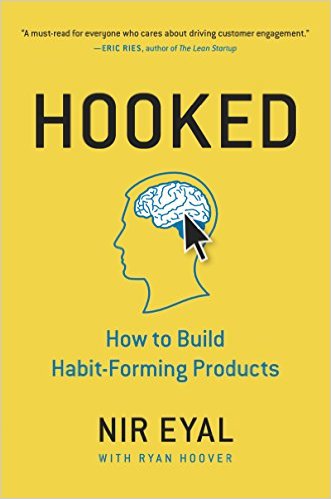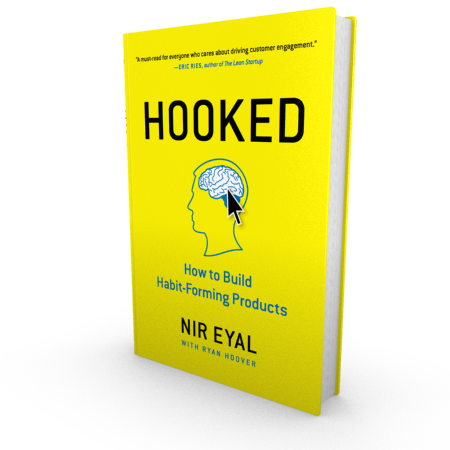I just got done reading Hooked: How to Build Habit-Forming Products by Nir Eyal and Ryan Hoover. It was epic!
 I think that as entrepreneurs, we tend to think too much about what we want when we build a product and don’t concentrate enough on how this product or widget fits into the lives of our customers.
I think that as entrepreneurs, we tend to think too much about what we want when we build a product and don’t concentrate enough on how this product or widget fits into the lives of our customers.
While some products only need to be consumed once every month or year, there are other products that need to capture mindshare on a day-to-day basis. This is particularly true of consumer apps, like SnapChat and Instagram. If the app doesn’t create a daily habit, it will slowly fade away.
This book talks about a few different specific strategies that you can use to increase product usage and get into the mindset of your customers.
I’m going to address a few negative reviews, cover some takeaways, and then include my notes at the end of this post.
One negative review reads, “It bothers me greatly to see a book outlining *how* to make the world more addictive – and weakly excusing itself for doing so.”
Yes, the book is basically a blueprint for getting people hooked on your products. If you’re searching for a philosophical book on the merits or negative implications of addictive products, it isn’t for you.
Another reads, “The book is fairly solid, despite some logical fallacies and clunky arguments, but the audiobook is terrible. It is peppered with mispronunciations, grammatical errors, and repeated sentences.”
I read the physical edition of the book, so I can’t address this critique, but I’d be interested to hear if others found the audio book to be low quality.
The last one I”ll address is, “There is value in the ideas taught in this book, but the writing is dry and dull.”
Personally, I don’t look to business books for creative or flavorful writing. I just want the information. I can see why others might find it to be dry though.
As a mid 20s dude, I only became aware of this and how I use social products after college. I did find that I would turn to apps like Instagram, FB, and SnapChat for happiness, because many of my friends were scattered throughout the country.
“Feelings of boredom, loneliness, frustration, confusion, and indecisiveness often instigate a slight pain or irritation and prompt an almost instantaneous and often mindless action to quell the negative sensation.”
Sometimes, I”ll find myself opening an app automatically like Facebook and totally forgetting that I just checked it 10 minutes ago. Other friends I have corroborate this experience.
Takeaway #2: Habits form from frequency
The more frequently something occurs, the more likely it is to become a habit (or a strong habit). This is important because “…companies increasingly find that their economic value is a function of the strength of the habits they create.”
It’s easy to forget this fact. I also think it holds a lot of implications for breaking bad habits. It makes sense to begin by decreasing the frequency with which you engage in them.
This is why notifications and emails are powerful ways to establish engagement and create habits in the minds of your users.
Takeaway #3: Identify core human needs and desires
“Take a human desire, preferably one that has been around for a really long time… identify that desire and use modern technology to take out steps.”
This is an awesome formula for coming up with new product ideas. It also underscores how technology can open up opportunities for new products. Rather than trying to create a new habit or instilling a new desire, it’s easier to work off of the ones that humanity already has!
My Notes
“The first-to-mind solution wins.”
“The more frequently the new behavior occurred, the stronger the habit became.”
“A 2010 study found that some habits can be formed in a matter of weeks while others can take more than five months.” Must also have perceived utility.
“Habit-forming products often start as nice-to-haves (vitamins), but once the habit is formed, they become must-haves (painkillers).”
Users should associate your product with a form of relief.
All humans want social acceptance. “The right motivators create action by offering the promise of desirable outcomes.”
“Influencing behavior by reducing the effort required to perform an action is more effective than increasing someone’s desire to do it.”
“The mind takes shortcuts informed by our surroundings to make quick and someones erroneous judgements.”
“Context also shapes perception.” World class violinist ignored.
“This study demonstrates how perception can form a personal reality based on how a product is framed, even when there is little relationship with objective quality.”
“People often anchor to one piece of information when making a decision.”
Motivation is increased when people feel like they are nearing a goal (progress bar).
“What draws us to act is not the sensation from the reward itself, but the need to alleviate the craving for that reward.”
“Once we figure out what will happen next, we become less excited by the experience.”
Using the phrase, “But you are free to accept or refuse” reaffirms the ability to choose and increases compliance.
“Researchers have shown that people who read a story about a character actually feel what the protagonist is feeling.”
You tend to value what you make more than what you buy.
Anything that you spend time on, you start to believe.
“Once users have invested the effort to acquire a skill, they are less likely to switch to a competing product.”
26% of mobile apps in 2010 were downloaded and used only once.
Technology is the cigarette of this century.
When developing new products, look for a habit path. A series of similar actions shared by loyal users.
